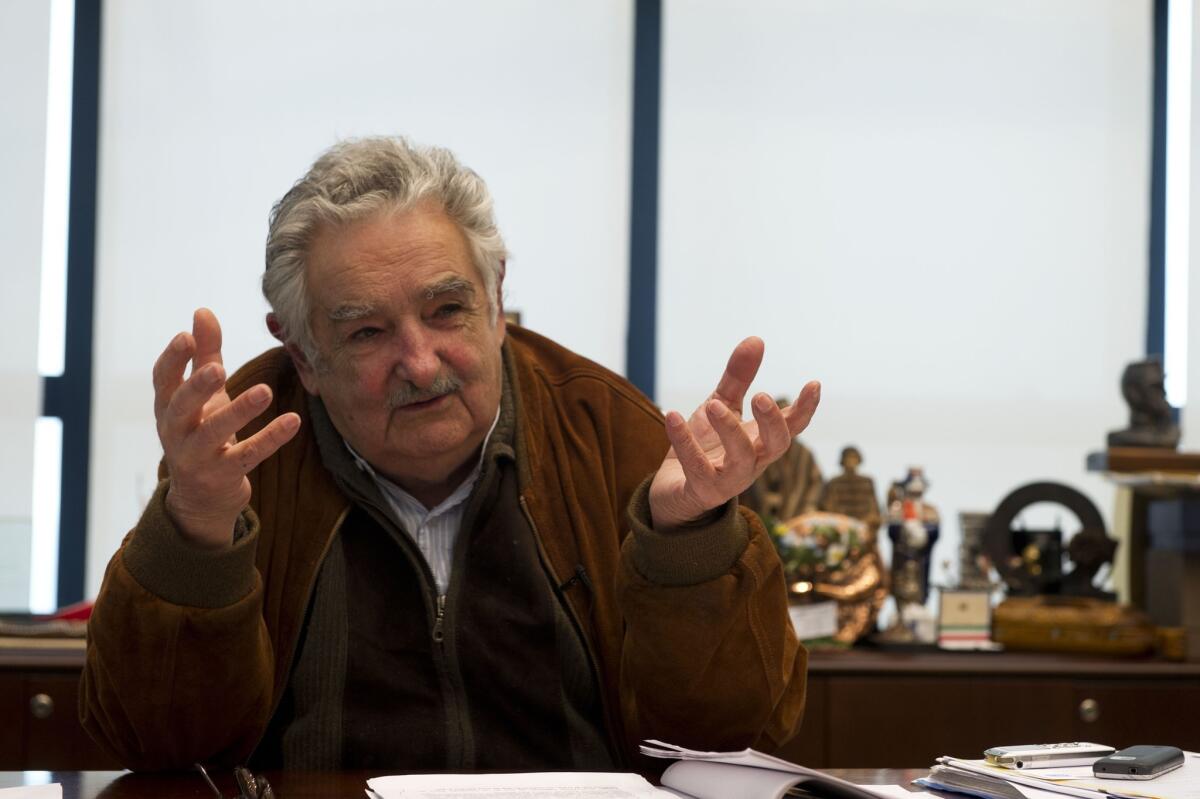Uruguayâs marijuana experiment

The United Statesâ take-no-prisoners (or, perhaps more aptly, take-too-many-prisoners) approach to drug control has few fans in Latin America, long the most violent battleground in the U.S. war on drugs. Uruguay, the smallest country in the region, has been the first, however, to openly rebel. It is expected soon to be the only nation to legalize the cultivation, sale and use of marijuana on a national scale.
President Obama has said on several occasions that âlegalization is not the answer.â At an Organization of American States meeting this year, White House drug czar R. Gil Kerlikowske rejected legalization as a âbumper-sticker approach.â
But there is not much the administration can do about Uruguayâs move. (In fact, it still has not formally announced what the federal response is to Colorado and Washington state laws, passed in November, legalizing marijuana for recreational use.) Indeed, the United States should pay special attention to developments in Uruguay, which may offer some important lessons for U.S. drug policy, at home and abroad.
Uruguay is a surprising trailblazer on the drug issue. Unlike much of Latin America, this is a country with limited drug consumption and little serious crime or violence. And despite the strong advocacy of current President Jose Mujica for legalization, polls report that nearly two-thirds of Uruguayans oppose it. So why, then, in a country with such widespread opposition and a mere 120,000 habitual cannabis users, is the government taking this groundbreaking step?
Mujica has championed legalization as a public security measure, a response to the Uruguayansâ deepening concerns. Yet it is hard to believe this is the presidentâs primary motive. After all, Uruguayâs crime rate is among the lowest in Latin America. Perhaps a better explanation is Mujicaâs own leadership and commitment to building a legacy of progressive accomplishments. In just one year, he has ushered through the regionâs most liberal abortion law and legislation recognizing same-sex marriage.
Uruguayâs initiative is also a response to Latin Americaâs deep frustration with the United Statesâ war on drugs. Although it is being scaled back within the U.S., the drug war remains a central priority of U.S. policy in the region â and in the eyes of Latin Americans, bears a sizable share of the blame for surging rates of crime and violence in Latin America.
The two central questions now become: First, will legalization, in fact, lower crime rates, divert people from more dangerous substances and reduce perceptions of insecurity? Or, as opponents claim, will it end up having little impact on crime while encouraging drug use? And, second, if Uruguayâs efforts succeed, would marijuana legalization be the right course for other nations?
The outcome of Uruguayâs initiative is uncertain, and retreat may ultimately be necessary. Indeed, even Mujica calls it an âexperimentâ and publicly acknowledges that it may fail. Black markets may be sustained by sales to juveniles and tourists â who would be forbidden to purchase it legally â or by people who want or need more than the government ration allows. Illegal sellers may even be able to offer lower prices.
Also, by blunting any remaining cultural stigma and anxieties about the health effects of marijuana, legalization could lead to an upturn in use, although the limited research available suggests that this is unlikely. But it is surely possible that Uruguayâs legal cannabis may find its way into neighboring Brazil and Argentina (as Coloradoâs will to New Mexico and Wyoming). Finally, criminals may just write off the lost profits from marijuana and turn to other illicit activities, such as extortion and robbery, or ratchet up sales of more risk-laden drugs.
Marijuana legalization in Uruguay will hardly affect the bulk of the hemisphereâs drug trade. Uruguay is neither a major drug producer nor a consequential trafficking corridor. And compared to Brazil or the United States, its market for narcotics is next to nonexistent. But Uruguayâs courageous experiment may start a trend across Latin America. Already, many countries are formally decriminalizing marijuana or simply turning a blind eye to its use.
The experience of tiny Uruguay will have a big impact, no doubt, but what happens in the United States will be especially critical to the future of drug policy. California alone consumes an estimated 500 tons of marijuana annually, compared to just 22 tons in all of Uruguay. But more relevant than market size, the U.S. will find it increasingly difficult to promote prohibition and strict enforcement in Latin American and elsewhere when its own citizens are pioneering a new course of toleration.
Peter Hakim and Cameron Combs are president emeritus and program assistant, respectively, of the Inter-American Dialogue, a Washington-based think tank.
More to Read
A cure for the common opinion
Get thought-provoking perspectives with our weekly newsletter.
You may occasionally receive promotional content from the Los Angeles Times.










